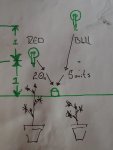Yes, I agree that 'bluer' light will shorten internoding.
I was speculating on mimicking the natural biome of the native local.
Reasoning that that ruderalis developed in an environment where blue light is abundant, takes a few hours for the sun to come up. Twilight, at the end of the day, lags on forever.
Conversely equatorial Sativas do the 12 12 thing under non oblique rays. Just wondering if Sativas are 'programmed' to more readily utilize longer photons.
Just spit balling, nothing really to add.
For myself, being curious, I divided my 8 foot room with blu on the right, and red on the left. Haven't been running it that way long enough to say much intelligent about it.
I will offer this.
I believe inadequate intensity leads to stretching. I find the tallest plants are out searching for light.
Curious however to see this little scenario developing.
Question.
Is light intensity or spectrum, more effective at reducing internode space ?
I am so cheap, I actually recycled a doodle !
View attachment 19374
The scene is correct. The units are not.
What we are looking at is accurate to my current crop.
The most intense light is is red, and situated on the left.
The blue light , on the right, is farther away and less intense.
I am seeing longer internode spacing under red light; even under greater intensity.
At the moment, 500 blue is shorter than 700 ppfd of red.
Pontificating,,, one could use even inadequate blu light, for better results, in a confined space.
Furthermore, a tiny source of blu light , in a predominantly red room, would hit above its' class.
Since I am rambling consider this,,,
I have seen photo's of T12 , finishers, UV, and full spectrum tubes mounted flush on high intensity fixtures.
Pre-acknowledging that I just argued this in the opposite direction - still - give your head a shake , man.
An HPS bulb will out hit a tube from three feet away.
Meaning,,, I could mash a plant into a florescent tube and still not achieve the same intensity as an HID sitting 36 inches away.
The most disappointing part of owning an Apogge Quantum sensor, is the realization of how fast light drops off.
I humbly suggest; if you folks are mussing about with these experiments: put it right up in their faces. Much of this fringe stuff is underpowered. Nothing seems to be as advertised. You buy into an idea, and they sell you a toy.
